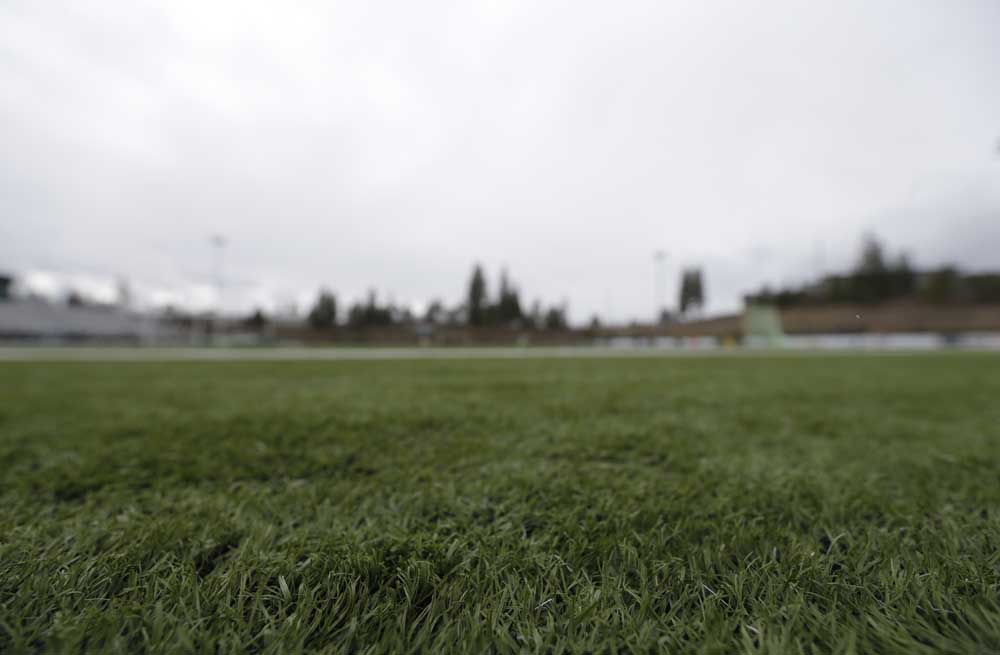Study finds no increased rate of cancer among soccer players
Published 11:56 pm Thursday, February 2, 2017

- ORIG / 03-11-16 / Joe Kline / The Bulletin The artificial turf field at Summit High School.
An investigation into a suspected cancer cluster among soccer players in Washington state found fewer than expected cases in the 5 to 24 age group, casting doubt on a theory that playing on artificial turf fields could increase the risk for cancer.
Officials from the Washington State Department of Health and the University of Washington School of Public Health launched the study after a coach for the UW women’s soccer team compiled a list of some 30 soccer players in the state who had been diagnosed with cancer, primarily Hodgkin and non-Hodgkin lymphoma, from the mid-1990s to 2015. The coach was particularly concerned about the number of goalkeepers with cancer and floated a theory that exposure to bits of recycled rubber used as infill in synthetic fields might be the cause. The list was later expanded to include more than 50 individuals with cancer, including some nonsoccer players who exercised on synthetic fields.
“We found that the number of cancers among all soccer players reported by the coach was less than expected, given rates of cancer in Washington residents of similar age,” said Dr. Cathy Wasserman, state epidemiologist for non-infectious conditions and lead investigator for the study.
The analysis calculated that given the number of soccer players in the state and the rate of cancer in the 5- to 24-year-old age group in the state, some 1,384 soccer players would develop cancer if there were no increased risk from synthetic turfs.
The finding suggests that the cancers reported by the coach, on its own, does not support a link between playing soccer and cancer. That was also true for goalkeepers and for players competing at higher levels, known as select or premier players.
Study limitations
The analysis could not identify all soccer players who had developed cancer, and the authors acknowledged other soccer players with cancer were likely missed. The analysis also had to make certain assumptions about how many children and young adults played soccer and how often. But the authors said those limitations were not substantial enough to change their conclusions.
“Even if our observed numbers were higher, they would have had to have been higher by hundreds of cases to have a ratio of observed to expected that was higher than one,” Wasserman said.
The researchers also said that gaps remain in their knowledge about potential risks with synthetic fields, and they would track the outcomes of studies under way in California and by the federal government looking at the components of the crumb rubber used as infill for synthetic fields and whether it poses any cancer risk.
“Based on what we know today and what we found in our investigation, we feel that we can recommend that (children continue playing soccer),” Wasserman said. “Active kids are healthy kids, and the benefits of staying active outweigh the hazards that we come into contact with.”
Dr. Archie Bleyer, a retired pediatric oncologist in Bend who has been studying the synthetic field issue, said the study is the most definitive analysis so far.
“I think it’s very reassuring,” he said.
Bleyer recently completed an analysis of the cancer risk with synthetic fields in California, and found no increase in the cancer rate from 2000 to 2014, despite the addition of many more synthetic fields.
The yet-to-be published data found a higher rate of cancer in counties with a higher density of soccer fields, but that was expected given the higher rate of cancer among higher socio-economic groups.
“People who can afford those communities and use those fields are of the ethnicity that genetically have a higher risk of developing a lymphoma,” he said.
Bleyer was also able to look at data going back more than 40 years for Marin and San Mateo counties, the two counties with the highest density of synthetic turf fields. Those counties had been included in a cancer-tracking database starting in 1973, well before the turf fields were put in. Neither of the counties showed any increase in lymphoma rates.
Lymphoma is the most common cancer among 14- to 30-year-olds in the U.S., and would be expected to be the most frequently observed about high school and college-age soccer players.
Cancer prevention
Bleyer argued that in the long run, artificial turf fields may prove to have a protective effect against cancer.
“It isn’t that the turf helps, it’s the exercise,” he said. “The turf allows for physical activity year-round of all types.”
The Washington state findings also came as relief to officials with the Bend FC Timbers soccer club, which is raising money to build four synthetic turf fields at the Pine Nursery Park in Bend.
“If it had gone the other way, we would have been dead in the water, and I would have just been personally worried,” said Tara Bilanski, the club’s technical director. “We play on those fields all the time.”
Bilanski said the club has gotten many questions from concerned parents about the cancer risk, and the findings would alleviate those concerns and allow the project to move forward. While Central Oregon has only one synthetic field — at Summit High School — she says the club often plays on synthetic turf in other parts of the state.
Synthetic fields, she said, last longer, require less maintenance and allow for great use for soccer and for other sports through a greater portion of the year.
“We can get more kiddos out there,” Bilanski said.
The club will need to raise $6 million for the turf and lighting and expects the first of the fields to be ready for use in 2020.
—Reporter: 541-633-2162, mhawryluk@bendbulletin.com






